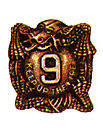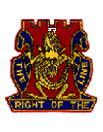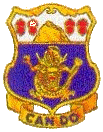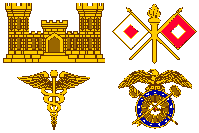 The
U.S. Army in China - 1900-1948
The
U.S. Army in China - 1900-1948
![]()
 The
U.S. Army in China - 1900-1948
The
U.S. Army in China - 1900-1948
![]()
OVERVIEWWhen one thinks of the Boxer Rebellion or American forces in China before World War II the first thoughts are of the Marines at Shanghai and Peking and the U.S. Navy's gunboats assigned to the Yangtze Patrol and South China Patrol. Movies like the San Pebbles and 55 Days at Peking tend to reinforce this perception of history. The Marines did the shore duty while the Navy did the sea duty. The U.S. Army is absent. A closer inspection of history tell us that this is not quite true.
Less known are the facts that the U.S. Army fielded almost five times as many troops than the Marines did to the China Relief Expedition during the Boxer Rebellion, provided the Legation Guard at Peking (now Beijing) between the end of the siege in August 1900 and 1905, and, almost forgotten, maintained a 1,000 person garrison at Tientsin (now Tianjin) from January 1912 until March 1938.
Until the Cold War brought large numbers of soldiers to Europe for 40+ years this deployment in China was the longest continuous stationing of U.S. Army forces on foreign soil.
 |
 |
 |
|
|
|
|
|
Legation Guard 1900-05 |
Legation Guard 1900-05 |
Tientsin 1912-1938 |
 |
 |
 |
|
|
|
|
|
|
|
Legation Guard 1900-01 |
BOXER REBELLION - CHINA RELIEF EXPEDITIONThe Boxer Rebellion began in Shantung Province in 1899. In May the foreign ministers in Peking requested armed guards from their fleet units in North China. Approximately 400 marines and sailors were dispatched from French, British, German, American, Italian, Austrian, Japanese and Russian ships in late May. Between June 17th and 20th the Chinese government ordered the foreigners to withdraw, and the German Minister was assassinated. The siege last 55 days and was relieved on August 14, 1900. The legation guards sent to Peking from the fleet at Taku in May and June 1900, were Marines and sailors drawn from ship's detachments available on the scene.
As the crisis matured more Marines were sent from the Philippines. The U.S. Army was tasked with rounding out this deployment and sent the 9th Infantry from the Philippines. The 14th Infantry, 6th Cavalry, and a battery of field artillery were sent directly from the United States. At this point total American forces on the ground were approximately 2,500. Major General A. Chaffee, U.S. Army commanded the combined Marine and Army force. This force joined other allied forces from Great Britain, India, France, Russia, Austria-Hungary, Germany, Italy, Australia and Japan in the relief of the foreign legations in Peking.
The Chinese coastal forts at Taku were taken on June 17th. The siege at Tientsin broken June 23rd. The Chinese City of Tientsin was stormed and taken July 14th. On August 4th the allied forces moved out to relieve the legations at Peking. Pei Tang was taken August 5th. Yang Tsun taken on August 6th. After continued skirmishing Peking was reached August 12th. After considerable fighting Peking was attacked and taken on August 14th and the legations relieved.
On August 15, as the allied force occupied Peking the 15th Infantry arrived from the United States giving the American forces approximately 3,000 ground troops in the region.
PEACETIME GARRISONS
Following the aftermath of the fighting most foreign forces were withdrawn by 1901. The treaty nations were allowed to maintain permanent forces at twelve points in the Peking, Tientsin, Chinwangtao triangle for the protection of the legations. The United States elected to maintain a guard force in Peking and depend on other nations to maintain the lines of communication between Peking and the sea.
Between 1900 and 1905 company sized detachments from the 9th and 14th infantry regiments were rotated in from the Philippines for this duty. In 1905 the Marine Corps was assigned this duty on a permanent basis. It retained this task until December 8, 1941 when it surrendered detachments at Peking, Tientsin and Chinwangtao to overwhelmingly superior numbers of Japanese forces1.
Following the Boxer Rebellion the moribund Ch'ing Empire attempted to reform itself into a modern nation. It utterly failed in this quest and insurrection, civil war and banditry stalked China. Northern China, the heart of the Empire was particularly hard hit with strife. Depending upon conditions Marines and sailors were put ashore at Chinwangtao and Tientsin to reinforce allied forces and protect American interests.
In the early morning of October 10, 1911 organized rebellion started in Hankow and quickly spread into revolution across all of China. In late 1911 the War Department was ordered to furnish a balanced force to protect American interests in North China under the terms of the Boxer Protocol of 1901. In January 1912 the 15th Infantry was deployed to Tientsin. This force, formalized as the China Expedition until 1923, settled down to a balanced force of two infantry battalions with supporting elements. Average strength was approximately 1,000 officers and other ranks. The principal component was two battalions and supporting companies of the 15th Infantry. In 1929 the 1st Battalion of the 15th Infantry, then stationed in the Philippine Islands, was inactivated. This left the regiment with a 2nd and 3rd battalion.
From arrival in 1912 until 1917 the China Expedition was billeted in various substandard buildings in Tientsin. Following the expulsion of the Germans from their concession in 1917 the U.S. took over the lease of the barracks in the former German Concession.
Through good times and bad the Americans, in conjunction with British, Italian, French, Russian until 1917, and Japanese forces protected the foreign residential areas at Tientisn and guarded the line of communications to Peking. In addition to the main garrison at Tientsin, company sized detachments were maintained at Chinwangtao and Tongshan throughout most of this deployment.
Until 1923 the organization was known as the China Expedition and reported to the Philippine Division (later the Philippine Department). On April 1, 1923, per War Department General Order 44, dated October 22, 1922, a separate command was organized reporting directly to the War Department, titled American Forces in China. This command consisted of all U.S. Army forces in China. This organization became U.S. Army Forces in China in on June 23, 1924, per War Department General Order 16. In 1929 the separate command was terminated per War Department General Order 5 dated February 11, 1929. Once again administrative control passed to the Philippine Department with the organization styled as U.S. Army Troops in China.
Strength of U.S. Army Forces in China
1901 - 1938
YEAR Tientsin
(1)Shanghai
(2)Peking
(3)Notes 1901
1902
1903
1904
1905
1906
1907
1908
1909
1910
1911
1912
1913
1914
1915
1916
1917
1918
1919
1920
1921
1922
1923
1924
1925
1926
1927
1928
1929
1930
19310
0
0
0
0
0
0
0
0
0
0
1,292
1,252
849
1,404
1,274
1,355
NA
NA
1,497
1,198
671
987
977
982
1,025
1,090
979
1,012
1,008
954ca. 80 - 160
ca. 80 - 160
ca. 80 - 160
ca. 80 - 160
ca. 80 - 160(1) 15th Infantry Regiment arrived at Tientsin, China During January of 1912. Strength includes supporting elements.
The 15th Infantry was withdrawn from China in March of 1938.
(2) The 31st Infantry Regiment was deployed at Shanghai, China from February 5, 1932 until June 30, 1932. It assisted the 4th Marines and Asiatic Fleet landing forces in protecting the American Defense Sector of the International Settlement.
(3) The U.S. Army maintained a legation guard of one or two companies at Peking from 1901 until 1905 when the U.S. Marine Corps took over this task.
1932 1933
1934
1935
1936
1937
1938758
722
754
841
NA
NATable Sources:
Noble, pg 32 except as noted.Condit & Turnbladh, pg 161 for 31st Infantry information.
In 1932 the Japanese attacked Chinese forces in the area surrounding Shanghai. The 4th Marines were the permanent American garrison in Shanghai's International Settlement. Several ships' detachments were landed immediately to reinforce the Marines and additional Marines were sent from the Philippines. To further protect American interests the 31st Infantry, permanently garrisoned in the Philippines at the time as a part of the Philippine Division (12th Infantry Division), was dispatched to Shanghai. It immediately took over half of the defense sector assigned to the Marine regiment. The 31st remained at Shanghai for four months and departed in early June 1932.
Following the invasion of northern China by Japan in July 1937 the position of all foreign forces in the region became difficult and exposed to harassment. On March 2, 1938 the 15th Infantry and its supporting elements were withdrawn to Ft. Lewis, Washington. This ended U.S. Army presence in China until World War II.
During World War II U.S. Army Air Force elements were stationed in China supporting the Chinese government and bombing raids on Japan. Following World War II the Army participated with other American forces in the repatriation of Japanese from China, provided logistics support to the Chinese government, and supported the effort to negotiate an end the the Chinese Civil War. By 1948 all Army elements had been withdrawn ending nearly 50 years of U.S. Army presence in China.
![]()
U.S. Army Homepage
U.S. Army Center for Military History
The Institute of Heraldry
Treaty Ports in China
China Relief Expedition 1900
The Boxer Rebellion I
The Boxer Rebellion II
The Boxer Rebellion III
15th Infantry Regiment
Old Tientsin - Modern Tianjin
The Old China Hands - A book written by a former member of the 15th Infantry between 1927 and 1930
Treaty Port and Asiatic Fleet Booklist
PARTIAL BIBLIOGRAPHYThe Eagle and the Dragon, Dennis L. Noble, Westport, Connecticut. Greenwood Press. 1990.
Hold High the Torch, Kenneth W. Condit and Edwin T. Turnbladh. Washington, DC, U.S. Marine Corps. 1960.
Footnote:
1 Marines in 1941 at Tientsin (49), Chinwangtao (22), and Peking (141). They were held as POW's for the entire war.
Prepared by Phil Abbey on May 2, 1999. Revised and uploaded July 17, 1999. Comments to pr_abbey@hotmail.com.